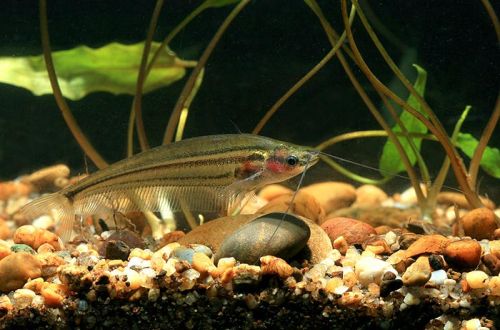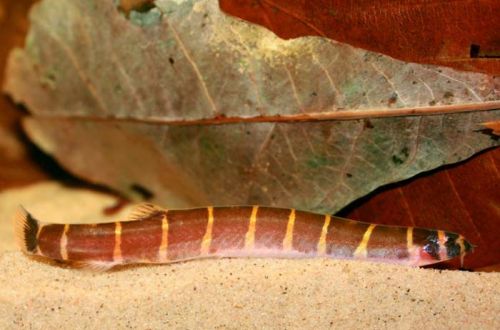
spotted glass catfish
Spotted glass catfish or False glass catfish, scientific name Kryptopterus macrocephalus, belongs to the Siluridae family. Peaceful, but at the same time carnivorous fish. It is easy to maintain and will not cause much trouble if the necessary conditions are maintained.

Contents
Habitat
It comes from Southeast Asia from the territory of southern Thailand, peninsular Malaysia and the large Sunda Islands (Sumatra, Borneo, Java). Inhabits peat bogs located among dense tropical forests. The typical habitat is a body of water poorly lit by the sun, unable to break through the dense canopy of trees. Coastal and aquatic vegetation consists mainly of shade-loving plants, ferns, and mosses. The soft silted bottom is littered with branches and foliage of trees. The abundance of plant organic matter colors the water in a rich brown color.
Brief information:
- The volume of the aquarium – from 100 liters.
- Temperature – 20-26°C
- Value pH — 4.0–7.0
- Water hardness – 0–7 dGH
- Substrate type – any
- Lighting – subdued
- Brackish water – no
- Water movement – little or no
- The size of the fish is 9–10 cm.
- Food – any sinking food
- Temperament – peaceful
- Content in a group of 3-4 individuals
Description
Outwardly, it is almost identical to another related species – Glass catfish. Adult individuals reach a length of 9-10 cm. The fish has an elongated body tapering towards the tail, somewhat compressed from the sides, resembling a blade. The head is large with two long antennae. The color is translucent light brown with scattered dark spots.
Food
Refers to small predators. In nature, it feeds on crustaceans, invertebrates and smaller fish. Despite this, in the home aquarium it will accept dry food in the form of flakes, granules. A couple of times a week, the diet should be diluted with live or frozen foods, such as brine shrimp, daphnia, bloodworms, etc.
Maintenance and care, arrangement of the aquarium
The optimal size of the aquarium for 2-3 fish starts from 100 liters. In the design, it is recommended to recreate a stop reminiscent of a natural habitat: a subdued level of lighting, a lot of snags and aquatic plants, including floating ones. At the bottom, you can place a layer of fallen leaves of some trees, during the decomposition of which processes similar to those that occur in natural reservoirs will occur. They will begin to release tannins, giving the water the necessary chemical composition and simultaneously coloring it in a characteristic brown color.
Successful keeping of Spotted Glass Catfish depends on maintaining stable water conditions within an acceptable range of temperatures and hydrochemical values. The desired stability is achieved through regular maintenance of the aquarium (changing part of the water, removing waste) and equipping it with the necessary equipment.
Behavior and Compatibility
A peaceful, timid catfish, but behind this apparent calmness one must not forget that this is a carnivorous species that will certainly eat any fish that can fit in its mouth. Compatible with other non-aggressive fish of comparable size. It is worth supporting in a group of 3-4 individuals.
Breeding / breeding
At the time of writing, no successful cases of breeding in home aquaria have been recorded.
Fish diseases
Being in favorable conditions is rarely accompanied by a deterioration in the health of fish. The occurrence of a particular disease will indicate problems in the content: dirty water, poor quality food, injuries, etc. As a rule, eliminating the cause leads to recovery, however, sometimes you will have to take medication. Read more about symptoms and treatments in the Aquarium Fish Diseases section.





